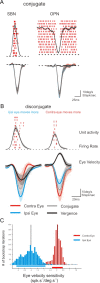Coding of microsaccades in three-dimensional space by premotor saccadic neurons
- PMID: 22323711
- PMCID: PMC6621699
- DOI: 10.1523/JNEUROSCI.5054-11.2012
Coding of microsaccades in three-dimensional space by premotor saccadic neurons
Abstract
Microsaccades are small, involuntary eye movements that are produced during fixation. While accurate visual perception requires precise binocular coordination during fixation, previous studies of the neural control of microsaccades measured the movement of one eye only. Here we show how premotor saccadic neurons control these small fixational eye movements in three-dimensional space. Microsaccadic eye movements, produced by monkeys trained to fixate targets presented at different depths, were similarly distributed in three-dimensional space during both near and far viewing. Single unit recordings of the neural activity of premotor neurons further revealed that the brainstem saccadic circuitry controls these minute disconjugate shifts of gaze by preferentially encoding the dynamic movement of an individual eye (i.e., integrated control of conjugate and vergence motion). These findings challenge the traditional notion that microsaccades are strictly conjugate and have important implications for studies that use microsaccades to evaluate visual and attentional processing, as well as certain neurological disorders.
Figures




References
-
- Betta E, Turatto M. Are you ready? I can tell by looking at your microsaccades. Neuroreport. 2006;17:1001–1004. - PubMed
-
- Brien DC, Corneil BD, Fecteau JH, Bell AH, Munoz DP. The behavioural and neurophysiological modulation of microsaccades in monkeys. J Eye Mov Res. 2009;3:1–12.
-
- Carpenter J, Bithell J. Bootstrap confidence intervals: when, which, what? A practical guide for medical statisticians. Stat Med. 2000;19:1141–1164. - PubMed
-
- Cornsweet TN. Determination of the stimuli for involuntary drifts and saccadic eye movements. J Opt Soc Am. 1956;46:987–993. - PubMed
Publication types
MeSH terms
LinkOut - more resources
Full Text Sources
